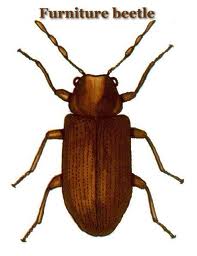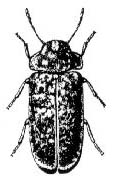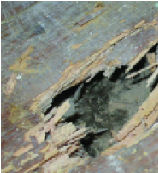| How to Identify Woodworm |
Identifying the Problem and the Type
There are two different ways in which you can identify woodworm. The first is the issue of determining if you have a woodworm problem at all. The second is ascertaining the species of woodworm that you have.
 So how do you know if you have a woodworm problem? Well, there are quite a few ways of identifying woodworm, and as always with pests, the earlier you notice the better. If you don’t notice at all then the first sign that you have a woodworm problem could be the loss in structural integrity of the wood in question. If this is a load bearing part of a building then it could be a very serious issue. Also, do not think that only old wood can get woodworm, they do not distinguish in that way. It could also be a chair or any other piece of wooden furniture that is affected as well.
So how do you know if you have a woodworm problem? Well, there are quite a few ways of identifying woodworm, and as always with pests, the earlier you notice the better. If you don’t notice at all then the first sign that you have a woodworm problem could be the loss in structural integrity of the wood in question. If this is a load bearing part of a building then it could be a very serious issue. Also, do not think that only old wood can get woodworm, they do not distinguish in that way. It could also be a chair or any other piece of wooden furniture that is affected as well.
 Fortunately, though, if you catch it early enough then it shouldn’t cause a problem. Woodworms are so called because they worm their way through wood, so one sure way of identifying woodworm is by the holes they create. In fact though they are not actually worms, they are actually beetles in their larval stage when they are burrowing through wood. When they finally come out of the wood, they come out as adult beetles looking to mate. Another way of identifying woodworm, therefore, is by spotting the beetles. There are quite a few types of wood boring beetles in the UK, but the most widespread are the Common Furniture Beetle and the Deathwatch Beetle. Although the first one is aptly named for its inclination towards furniture, the second one was not named for their propensity to cause death, in fact they are not dangerous in that way at all.
Fortunately, though, if you catch it early enough then it shouldn’t cause a problem. Woodworms are so called because they worm their way through wood, so one sure way of identifying woodworm is by the holes they create. In fact though they are not actually worms, they are actually beetles in their larval stage when they are burrowing through wood. When they finally come out of the wood, they come out as adult beetles looking to mate. Another way of identifying woodworm, therefore, is by spotting the beetles. There are quite a few types of wood boring beetles in the UK, but the most widespread are the Common Furniture Beetle and the Deathwatch Beetle. Although the first one is aptly named for its inclination towards furniture, the second one was not named for their propensity to cause death, in fact they are not dangerous in that way at all.
 You might also notice bore dust. That is, the dust which is created by the woodworm as they bore their way through the wood. This is also known as frass. This is a good way to tell that you have a current woodworm infestation as well. Sometimes you will find signs of woodworm, but the beetles have actually moved on. When you call in a pest controller for woodworm, the first thing they will do is survey the affected area to ascertain if it a present problem or a past one.
You might also notice bore dust. That is, the dust which is created by the woodworm as they bore their way through the wood. This is also known as frass. This is a good way to tell that you have a current woodworm infestation as well. Sometimes you will find signs of woodworm, but the beetles have actually moved on. When you call in a pest controller for woodworm, the first thing they will do is survey the affected area to ascertain if it a present problem or a past one.
The next stage in identifying woodworm, if you do have an active woodworm problem, is to classify which kind you have. As already mentioned, woodworm is actually the larval stages of different types of beetle, and depending on which type it is will determine the kind of treatment that will be used. There are a range of different approaches to treatment available, from unobtrusive water-based treatment to fogging the area with insecticide. Which is more appropriate will depend on the size of the infestation and what sort of woodworm you have.
If you do suspect that you have found a woodworm infestation, get in contact immediately so that we can assess the damage and recommend the best treatment course available.
We have treated over 11,000 woodworm cases in the UK. Request a quotation now.
|
| |
|
|
|